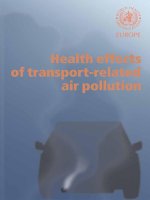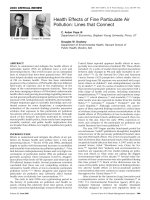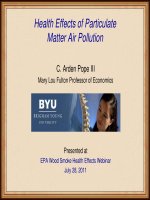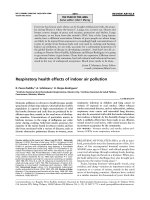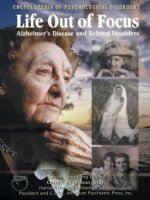RESPIRATORY HEALTH EFFECTS OF PASSIVE SMOKING: LUNG CANCER AND OTHER DISORDERS ppt
Bạn đang xem bản rút gọn của tài liệu. Xem và tải ngay bản đầy đủ của tài liệu tại đây (63.79 KB, 20 trang )
EPA/600/6-90/006F
December 1992
RESPIRATORY HEALTH EFFECTS
OF PASSIVE SMOKING:
LUNG CANCER AND OTHER DISORDERS
Major funding for this report has been provided by the Indoor Air Division,
Office of Atmospheric and Indoor Air Programs
Office of Health and Environmental Assessment
Office of Research and Development
U.S. Environmental Protection Agency
Washington, D.C.
ii
DISCLAIMER
This document has been reviewed in accordance with U.S. Environmental Protection Agency policy
and approved for publication. Mention of trade names or commercial products does not constitute
endorsement or recommendation for use.
iii
CONTENTS
Tables viii
Figures xiii
Foreword xv
Preface xvi
Authors, Contributors, and Reviewers xvii
1. SUMMARY AND CONCLUSIONS 1-1
1.1. MAJOR CONCLUSIONS 1-1
1.2. BACKGROUND 1-2
1.3. PRIMARY FINDINGS 1-4
1.3.1. ETS and Lung Cancer 1-6
1.3.1.1. Hazard Identification 1-6
1.3.1.2. Estimation of Population Risk 1-11
1.3.2. ETS and Noncancer Respiratory Disorders 1-12
2. INTRODUCTION 2-1
2.1. FINDINGS OF PREVIOUS REVIEWS 2-2
2.2. DEVELOPMENT OF EPA REPORT 2-5
2.2.1. Scope 2-5
2.2.2. Use of EPA's Guidelines 2-6
2.2.3. Contents of This Report 2-8
3. ESTIMATION OF ENVIRONMENTAL TOBACCO SMOKE EXPOSURE 3-1
3.1. INTRODUCTION 3-1
3.2. PHYSICAL AND CHEMICAL PROPERTIES 3-2
3.3. ASSESSING ETS EXPOSURE 3-10
3.3.1. Environmental Concentrations of ETS 3-12
3.3.1.1. Markers for Environmental Tobacco Smoke 3-18
3.3.1.2. Measured Exposures to ETS-Associated Nicotine and RSP 3-22
3.3.2. Biomarkers of ETS Exposure 3-40
3.3.3. Questionnaires for Assessing ETS Exposures 3-48
3.4. SUMMARY
3-51
4. HAZARD IDENTIFICATION I: LUNG CANCER IN ACTIVE SMOKERS,
LONG-TERM ANIMAL BIOASSAYS, AND GENOTOXICITY STUDIES 4-1
CONTENTS (continued)
iv
4.1. INTRODUCTION 4-1
4.2. LUNG CANCER IN ACTIVE SMOKERS 4-2
4.2.1. Time Trends 4-2
4.2.2. Dose-Response Relationships 4-5
4.2.3. Histological Types of Lung Cancer and Associations With Smoking 4-10
4.2.4. Proportion of Risk Attributable to Active Smoking 4-23
4.3. LIFETIME ANIMAL STUDIES 4-23
4.3.1. Inhalation Studies 4-25
4.3.2. Intrapulmonary Implantations of Cigarette Smoke Condensates 4-25
4.3.3. Mouse Skin Painting of Cigarette Smoke Condensates 4-26
4.4. GENOTOXICITY 4-27
4.5. SUMMARY AND CONCLUSIONS 4-27
5. HAZARD IDENTIFICATION II: INTERPRETATION OF EPIDEMIOLOGIC
STUDIES ON ENVIRONMENTAL TOBACCO SMOKE AND LUNG CANCER 5-1
5.1. INTRODUCTION 5-1
5.2. RELATIVE RISKS USED IN STATISTICAL INFERENCE 5-15
5.2.1. Selection of Relative Risks 5-15
5.2.2. Downward Adjustment to Relative Risk for Smoker
Misclassification Bias 5-22
5.3. STATISTICAL INFERENCE 5-25
5.3.1. Introduction 5-25
5.3.2. Analysis of Data by Study and Country 5-31
5.3.2.1. Tests for Association 5-31
5.3.2.2. Confidence Intervals 5-34
5.3.3 Analysis of Data by Exposure Level 5-36
5.3.3.1. Introduction 5-36
5.3.3.2. Analysis of High-Exposure Data 5-37
5.3.3.3. Tests for Trend 5-40
5.3.4. Conclusions 5-51
5.4. STUDY RESULTS ON FACTORS THAT MAY AFFECT
LUNG CANCER RISK 5-48
5.4.1. Introduction 5-48
5.4.2. History of Lung Disease 5-51
5.4.3. Family History of Lung Disease 5-53
5.4.4. Heat Sources for Cooking or Heating 5-53
5.4.5. Cooking With Oil 5-54
5.4.6. Occupation 5-54
5.4.7. Dietary Factors 5-55
5.4.8. Summary on Potential Modifying Factors 5-60
5.5. ANALYSIS BY TIER AND COUNTRY 5-60
5.6. CONCLUSIONS FOR HAZARD IDENTIFICATION 5-63
5.6.1. Criteria for Causality 5-63
CONTENTS (continued)
v
5.6.2. Assessment of Causality 5-67
5.6.3. Conclusion 5-68
6. POPULATION RISK OF LUNG CANCER FROM PASSIVE SMOKING 6-1
6.1. INTRODUCTION 6-1
6.2. PRIOR APPROACHES TO ESTIMATION OF POPULATION RISK 6-1
6.2.1. Examples Using Epidemiologic Data 6-2
6.2.2. Examples Based on Cigarette-Equivalents 6-5
6.3. THIS REPORT'S ESTIMATES OF LUNG CANCER MORTALITY
ATTRIBUTABLE TO ETS IN THE UNITED STATES 6-8
6.3.1. Introduction and Background 6-8
6.3.2. Parameters and Formulae for Attributable Risk 6-10
6.3.3. U.S. Lung Cancer Mortality Estimates Based on Results of
Combined Estimates from 11 U.S. Studies 6-16
6.3.3.1. U.S. Lung Cancer Mortality Estimates for Female
Never-Smokers 6-17
6.3.3.2. U.S. Lung Cancer Mortality Estimates for Male
Never-Smokers 6-17
6.3.3.3. U.S. Lung Cancer Mortality Estimates for Long-Term
(5+ Years) Former Smokers 6-20
6.3.4. U.S. Lung Cancer Mortality Estimates Based on Results of the
Fontham et al. (1991) Study (FONT) 6-21
6.3.5. Sensitivity to Parameter Values 6-27
6.4. SUMMARY AND CONCLUSIONS ON POPULATION RISK 6-29
7. PASSIVE SMOKING AND RESPIRATORY DISORDERS
OTHER THAN CANCER 7-1
7.1. INTRODUCTION 7-1
7.2. BIOLOGICAL MECHANISMS 7-2
7.2.1. Plausibility 7-2
7.2.2. Effects of Exposure In Utero and During the First
Months of Life 7-3
7.2.3. Long-Term Significance of Early Effects on
Airway Function 7-6
7.2.4. Exposure to ETS and Bronchial Hyperresponsiveness 7-7
7.2.5. ETS Exposure and Atopy 7-9
7.3. EFFECT OF PASSIVE SMOKING ON ACUTE RESPIRATORY
ILLNESSES IN CHILDREN 7-10
7.3.1. Recent Studies on Acute Lower Respiratory Illnesses 7-11
7.3.2. Summary and Discussion of Acute Respiratory Illnesses 7-20
7.4. PASSIVE SMOKING AND ACUTE AND CHRONIC
MIDDLE EAR DISEASES 7-21
7.4.1. Recent Studies on Acute and Chronic Middle Ear Diseases 7-22
CONTENTS (continued)
vi
7.4.2. Summary and Discussion of Middle Ear Diseases 7-28
7.5. EFFECT OF PASSIVE SMOKING ON COUGH, PHLEGM,
AND WHEEZING 7-30
7.5.1. Recent Studies on the Effect of Passive Smoking on Cough,
Phlegm, and Wheezing 7-30
7.5.2. Summary and Discussion on Cough, Phlegm, and
Wheezing 7-41
7.6. EFFECT OF PASSIVE SMOKING ON ASTHMA 7-43
7.6.1. Recent Studies on the Effect of Passive Smoking on
Asthma in Children 7-44
7.6.2. Summary and Discussion on Asthma 7-50
7.7. ETS EXPOSURE AND SUDDEN INFANT DEATH SYNDROME 7-51
7.8. PASSIVE SMOKING AND LUNG FUNCTION IN CHILDREN 7-57
7.8.1. Recent Studies on Passive Smoking and Lung Function
in Children 7-57
7.8.2. Summary and Discussion on Pulmonary Function
in Children 7-63
7.9. PASSIVE SMOKING AND RESPIRATORY SYMPTOMS AND
LUNG FUNCTION IN ADULTS 7-64
7.9.1. Recent Studies on Passive Smoking and Adult Respiratory
Symptoms and Lung Function 7-64
7.9.2. Summary and Discussion on Respiratory Symptoms and
Lung Function in Adults 7-68
8. ASSESSMENT OF INCREASED RISK FOR RESPIRATORY ILLNESSES IN
CHILDREN FROM ENVIRONMENTAL TOBACCO SMOKE 8-1
8.1. POSSIBLE ROLE OF CONFOUNDING 8-1
8.2. MISCLASSIFICATION OF EXPOSED AND UNEXPOSED SUBJECTS 8-2
8.2.1. Effect of Active Smoking in Children 8-2
8.2.2. Misreporting and Background Exposure 8-3
8.3. ADJUSTMENT FOR BACKGROUND EXPOSURE 8-5
8.4. ASSESSMENT OF RISK 8-9
8.4.1. Asthma 8-10
8.4.2. Lower Respiratory Illness 8-13
8.4.3. Sudden Infant Death Syndrome 8-15
8.5. CONCLUSIONS 8-15
ADDENDUM: PERTINENT NEW STUDIES ADD-1
APPENDIX A: REVIEWS AND TIER ASSIGNMENTS FOR EPIDEMIOLOGIC
STUDIES OF ETS AND LUNG CANCER A-1
APPENDIX B: METHOD FOR CORRECTING RELATIVE RISK FOR
SMOKER MISCLASSIFICATION B-1
CONTENTS (continued)
vii
APPENDIX C: LUNG CANCER MORTALITY RATES ATTRIBUTABLE TO
SPOUSAL ETS IN INDIVIDUAL EPIDEMIOLOGIC STUDIES C-1
APPENDIX D: STATISTICAL FORMULAE D-1
SELECTED BIBLIOGRAPHY
R-1
viii
TABLES
3-1 Distribution of constituents in fresh, undiluted mainstream smoke and
diluted sidestream smoke from nonfilter cigarettes 3-5
3-2 Example sidestream cigarette smoke deliveries 3-8
3-3 Tobacco-specific N-nitrosamines in indoor air (ng/m ) 3-17
3
3-4 Weekly average concentrations of each measure of exposure by parental
smoking status in the cross-sectional study, Minnesota, 1989 3-36
3-5 Studies measuring personal exposure to airborne nicotine associated
with ETS for nonsmokers 3-37
3-6 Studies measuring personal exposure to particulate matter associated
with ETS for nonsmokers 3-38
3-7 Approximate relations of nicotine as the parameter between
nonsmokers, passive smokers, and active smokers 3-43
4-1 Main characteristics of major cohort studies on the
relationship between smoking and cancer 4-6
4-2 Lung cancer mortality ratios prospective studies 4-8
4-3 Lung cancer mortality ratios for men and women, by current
number of cigarettes smoked per day prospective studies 4-9
4-4 Relationship between risk of lung cancer and duration of smoking in
men, based on available information from cohort studies 4-11
4-5 Lung cancer mortality ratios for males, by age of
smoking initiation prospective studies 4-12
4-6 Relationship between risk of lung cancer and number of years
since stopping smoking, in men, based on available information
from cohort studies 4-13
4-7 Relative risks of lung cancer in some large cohort studies among
men smoking cigarettes and other types of tobacco 4-15
4-8 Age-adjusted lung cancer mortality ratios for males and females,
by tar and nicotine (T/N) in cigarettes smoked 4-17
4-9 Relative risk for lung cancer by type of cigarette smoked (filter vs.
nonfilter), in men, based on cohort and case-control studies 4-17
TABLES (continued)
ix
4-10 Main results of studies dealing with the relationship between
smoking and different histological types of lung cancer 4-18
4-11 Lung cancer deaths attributable to tobacco smoking in certain countries 4-24
5-1 Epidemiologic studies on ETS and lung cancer in this report and
tier ranking 5-4
5-2 Studies by location, time, size, and ETS exposure 5-6
5-3 Case-control studies of ETS: characteristics 5-8
5-4 Diagnosis, confirmation, and exclusion of lung cancer cases 5-12
5-5 Estimated relative risk of lung cancer from spousal ETS
by epidemiologic study (crude and adjusted for cofactors) 5-16
5-6 Effect of statistical adjustments for cofactors on risk estimates
for passive smoking 5-20
5-7 Alternative estimates of lung cancer relative risks associated
with active and passive smoking 5-23
5-8 Estimated correction for smoker misclassification 5-26
5-9 Statistical measures by individual study and pooled by country,
corrected for smoker misclassification 5-28
5-10 Statistical measures for highest exposure categories only 5-39
5-11 Exposure response trends for females 5-41
5-12 Reported p-values of trend tests for ETS exposure by study 5-44
5-13 P-values of tests for effect and for trend by individual study 5-46
5-14 Other risk-related factors for lung cancer evaluated in selected studies 5-52
5-15 Dietary effects in passive smoking studies of lung cancer in females 5-57
5-16 Classification of studies by tier 5-62
5-17 Summary data interpretation by tiers within country 5-64
TABLES (continued)
x
6-1 Definition and estimates of relative risk of lung cancer for 11 U.S. studies
combined for various exposure sources and baselines; population parameter
definitions and estimates used to calculate U.S. population-attributable
risk estimates for ETS 6-11
6-2 Estimated female lung cancer mortality by attributable sources
for United States, 1985, using the pooled relative risk estimate
from 11 U.S. studies 6-18
6-3 Female and male lung cancer mortality estimates by attributable
ETS sources for United States, 1985, using 11 U.S. studies
(never-smokers and former smokers who have quit 5+ years) 6-22
6-4 Female lung cancer mortality estimates by attributable sources
for United States, 1985, using both the relative risk estimates
and Z values from the Fontham et al. (1991) study 6-24
6-5 Female and male lung cancer mortality estimates by attributable
ETS sources for United States, 1985, using the Fontham et al. (1991) study
(never-smokers and former smokers who have quit 5+ years) 6-25
6-6 Effect of single parameter changes on lung cancer mortality due to
ETS in never-smokers and former smokers who have quit 5+ years 6-28
7-1 Studies on respiratory illness referenced in the Surgeon General's
and National Research Council's reports of 1986 7-11
7-2 Recent epidemiologic studies of effects of passive smoking on
acute lower respiratory tract illnesses (LRIs) 7-12
7-3 Studies on middle ear diseases referenced in the Surgeon
General's report of 1986 7-22
7-4 Recent epidemiologic studies of effects of passive smoking on
acute and chronic middle ear diseases 7-23
7-5 Studies on chronic respiratory symptoms referenced in the Surgeon
General's and National Research Council's reports of 1986 7-31
7-6 Recent epidemiologic studies of effects of passive smoking on
cough, phlegm, and wheezing 7-32
7-7 Recent epidemiologic studies of effects of passive smoking on
asthma in childhood 7-45
TABLES (continued)
xi
7-8 Epidemiologic studies of effects of passive smoking on
incidence of sudden infant death syndrome (SIDS) 7-53
7-9 Studies on pulmonary function referenced in the Surgeon General's
and National Research Council's reports of 1986 7-58
7-10 Recent epidemiologic studies on the effects of passive smoking
on lung function in children 7-59
7-11 Recent epidemiologic studies on the effects of passive smoking
on adult respiratory symptoms and lung function 7-65
8-1 Adjusted relative risks for "exposed children." Adjusted or background
exposure based on body cotinine ratios between "exposed" and "unexposed"
and equation 8-1 8-8
8-2 Behavior variations in adjusted relative risks from equation 8-1 when the
observed relative risks and Z ratios are close together 8-9
8-3 Range of estimates of adjusted relative risk and attributable
risk for asthma induction in children based on both threshold
and nonthreshold models 8-11
A-1 Study scores for tier assignments A-8
A-2 Total scores and tier assignment A-18
B-1 Observed ratios of occasional smokers to current smokers
(based on cotinine studies) B-4
B-2 Examples, using five U.S. studies, of differences in smoker misclassification
bias between EPA estimates and those of P.N. Lee regarding passive smoking
relative risks for females B-5
B-3 Misclassification of female current smokers B-7
B-4 Misclassification of female former smokers reported as never-smokers
based on discordant answers B-11
B-5 Misclassification of female lung cancer cases B-12
B-6 Deletions from the "never" columns in Tables B-13 and B-16 and
corrected elements B-13
B-7 Notation for distribution of reported female lung cancer cases and
controls by husband's smoking status B-15
TABLES (continued)
xii
B-8 Notation for distribution of subjects by observed and true smoking status B-15
B-9 Observed ratios of female former smokers to ever-smokers in the U.S., U.K.,
and Swedish studies: populations or controls (numbers or percentage) B-16
B-10 Notation for observed lung cancer relative risks for exposed (k=1) and
nonexposed (k=0) wives by the wife's smoking status, using average
never-smoking wives RR(a) as the reference category B-18
0
B-11 Prevalences and estimates of lung cancer risk associated with active
and passive smoking B-19
B-12 Observed ratios of current smoker lung cancer risk to ever-smoker
risk for females B-23
B-13 Observed smoking prevalence among the controls Correa example B-26
B-14 Observed relative risks Correa example B-27
B-15 Crude case table, prevalence of cases by smoking status Correa example B-27
B-16 Normalized case table, prevalence of cases by smoking status
Correa example B-27
B-17 Distribution of subjects by observed and true smoking status for wives
in Correa example B-28
C-1 Female lung cancer mortality from all causes in case-control studies C-2
C-2 Parameter values used to partition female lung cancer mortality
into component sources C-4
C-3 Female lung cancer mortality rates by attributable source C-6
C-4 Lung cancer mortality rates of female ever-smokers (ES) and never-smokers (NS)
by exposure status C-8
xiii
FIGURES
3-1 Diagram for calculating the RSP mass from ETS emitted into any
occupied space as a function of the smoking rate and removal rate (N) 3-14
3-2 Diagram to calculate the ETS-associated RSP mass concentration in g/m
3
in a space as a function of total mass of ETS-generated RSP emitted in mg
(determined from Figure 3-1) and the volume of a space 3-15
3-3 Range of average indoor concentrations for notable ETS contaminants associated
with smoking occupancy of different indoor environments 3-16
3-4 Mean, standard deviation, and maximum and minimum nicotine values measured
in different indoor environments with smoking occupancy 3-23
3-5 Mean, standard deviation, and maximum and minimum concentrations
of RSP mass measured in different indoor environments for smoking and
nonsmoking occupancy 3-26
3-6 Weeklong RSP mass and nicotine measurements in 96 residences
with a mixture of sources. 3-27
3-7 Range of average nicotine concentrations and range of maximum
and minimum values measured by different indoor environments
for smoking occupancy from studies shown in Figure 3-4 3-28
3-8 Range of average RSP mass concentrations and range of maximum
and minimum values measured by different indoor environments
for smoking occupancy from studies shown in Figure 3-5 3-29
3-9 Cumulative frequency distribution and arithmetic means of vapor-phase
nicotine levels over a 1-week period in the main living area in residences
in Onondaga and Suffolk Counties in New York State between January and
April 1986 3-31
3-10 Cumulative frequency distribution and arithmetic means of RSP mass levels by
vapor-phase nicotine levels measured over a 1-week period in the main living
area in residences in Onondaga and Suffolk Counties in New York State between
January and April 1986 3-31
3-11 Monthly mean RSP mass concentrations in six U.S. cities 3-32
3-12a Week-long nicotine concentrations measured in the main living area of
96 residences versus the number of questionnaire-reported cigarettes smoked
during the air-sampling period 3-33
FIGURES (continued)
xiv
3-12b Week-long RSP mass concentrations measured in the main living area
of 96 residences versus the number of questionnaire-reported cigarettes
smoked during the air-sampling period 3-34
3-13 Cumulative frequency distribution of RSP mass concentrations from
central site ambient and personal monitoring of smoke-exposed and
nonsmoke-exposed individuals 3-39
3-14 Average cotinine t by age groups 3-41
½
3-15 Distribution of individual concentrations of urinary cotinine by degree
of self-reported exposure to ETS 3-44
3-16 Urinary cotinine concentrations by number of reported exposures to
tobacco smoke in the past 4 days among 663 nonsmokers, Buffalo,
New York, 1986 3-45
3-17 Average cotinine/creatinine levels for subgroups of nonsmoking
women defined by sampling categories of exposure or by
self-reporting exposure to ETS from different sources during
the 4 days preceding collection of the urine sample 3-47
4-1 Age-adjusted cancer death rates for selected sites, males,
United States, 1930-1986 4-3
4-2 Age-adjusted cancer death rates for selected sites, females,
United States, 1930-1986 4-4
4-3 Relative risk of lung cancer in ex-smokers, by number of years
quit, women, Cancer Prevention Study II 4-14
5-1 Test statistics for hypothesis RR = 1, all studies 5-32
5-2 Test statistics for hypothesis RR = 1, USA only 5-32
5-3 Test statistics for hypothesis RR = 1, by country 5-33
5-4 Test statistics for hypothesis RR = 1, tiers 1-3 only 5-33
5-5 90% confidence intervals, by country 5-35
5-6 90% confidence intervals, by country, tiers 1-3 only 5-35
xv
FOREWORD 1/19/93
xvi
PREFACE
This assessment of the respiratory health effects associated with passive smoking has been prepared
by the Human Health Assessment Group, Office of Health and Environmental Assessment, Office of Research
and Development, which is responsible for the report's scientific accuracy and conclusions. The assessment
was prepared at the request of the Indoor Air Division, Office of Atmospheric and Indoor Air Programs, Office
of Air and Radiation, which defined the assessment's scope and provided funding.
The report has been developed under the authority of Title IV of Superfund (The Radon Gas and
Indoor Air Quality Research Act of 1986) to provide information and guidance on the potential hazards of
indoor air pollutants.
Two drafts of this report were made available for public review and comments, the first in June 1990
(reviewed by the Agency's Science Advisory Board [SAB] in December 1990) and a significantly revised draft
in May 1992 (reviewed by the SAB in July 1992). This report reflects the comments received from those
reviews.
A comprehensive search of the scientific literature for this report is complete through September 1991.
In addition, pertinent studies published through July 1992 have been included in the analysis in response to
recommendations made by reviewers.
Due to both resource and time constraints, the scope of this report has been limited to an analysis of
respiratory effects, primarily lung cancer in nonsmoking adults and noncancer respiratory illnesses in children,
with emphasis on the epidemiologic data. Further, because two thorough reviews on passive smoking were
completed in 1986 (by the U.S. Surgeon General and the National Research Council), this document provides a
summary of those reports with a more comprehensive analysis of the literature appearing subsequent to those
reports and an integration of the results.
xvii
AUTHORS, CONTRIBUTORS, AND REVIEWERS
This document was prepared by the Office of Health and Environmental Assessment (OHEA) within
the Office of Research and Development, with major contract funding provided by the Indoor Air Division
within the Office of Air and Radiation's Office of Atmospheric and Indoor Air Programs. Steven P. Bayard
1
was the OHEA project manager with overall responsibility for the contents of this report and its conclusions.
Other OHEA staff members responsible for the scientific content of sections of this document are Jennifer
Jinot and Aparna M. Koppikar. Jennifer Jinot and Steven Bayard were the scientific editors.
1 1
AUTHORS
Major portions of this revised report were prepared by ICF Incorporated, Fairfax, Virginia, under EPA
Contract No. 68-00-0102. While OHEA staff provided technical editing and incorporated reviewers'
comments into each chapter in an attempt to develop a comprehensive and consistent document, the following
people were the primary authors:
Chapter 1: Steven P. Bayard
Chapter 2: Jennifer Jinot
Chapter 3: Brian P. Leaderer
2
Chapter 4: Jennifer Jinot
Chapters 5/6: Kenneth G. Brown
3
Chapter 7: Fernando D. Martinez
4
Chapter 8: Fernando D. Martinez and Steven P. Bayard
Appendix A: Kenneth G. Brown, Neal R. Simonsen, and A. Judson Wells
3 3
Appendix B: A. Judson Wells
Appendix C: Kenneth G. Brown
Appendix D: Kenneth G. Brown and Neal R. Simonsen
Human Health Assessment Group, Office of Health and Environmental Assessment, U.S. EPA,
1
Washington, DC 20460.
J.B. Pierce Foundation Laboratory, Department of Epidemiology and Public Health, Yale
2
University School of Medicine, New Haven, CT 06520. Subcontractor to ICF, Inc.
Kenneth G. Brown, Inc., P.O. Box 16608, Chapel Hill, NC 27516. Subcontractor to ICF, Inc.
3
Division of Respiratory Sciences, University of Arizona Medical Center, Tucson, AZ 85724.
4
Subcontractor to ICF, Inc.
xviii
CONTRIBUTORS
Numerous persons have provided helpful discussions or responded to requests for preprints, data, and
other material relevant to this report. The authors are grateful to W.J. Blot, N. Britten, R.C. Brownson, P.A.
Buffler, T.L. Butler, D.B. Coultas, K.M. Cummings, J. Fleiss, E.T.H. Fontham, Y.T. Gao, L. Garfinkel, S.
Glantz, N.J. Haley, T. Hirayama, D.J. Hole, C. Humble, G.C. Kabat, J.C. Kleinman, G.J. Knight, L.C. Koo, M.
Layard, M.D. Lebowitz, P.N. Lee, P. Macaskill, G.E. Palomaki, J.P. Pierce, J. Repace, H. Shimizu, W.F.
Stewart, D. Trichopoulos, R.W. Wilson, and A. Wu-Williams.
REVIEWERS
This final report was preceded by two earlier drafts: an External Review Draft (EPA/600/6-90/006A)
published in May 1990, and an SAB Review Draft (EPA/600/6-90/006B) published in May 1992. The
External Review Draft was released for public review and comment on June 25, 1990, and was subsequently
reviewed by the EPA Science Advisory Board (SAB) on December 4 and 5, 1990. The SAB Review Draft
incorporated many of the public comments and especially the valuable advice presented in the SAB's April 19,
1991, report to the Agency. In addition, many reviewers both within and outside the Agency provided
assistance at various internal review stages.
The second Review Draft also was reviewed by the SAB on July 21 and 22, 1992, which provided its
report to the Agency on November 20, 1992. The authors wish to thank all those who sought to improve the
quality of this report with their comments and are particularly grateful to the SAB for its advice.
The following members of the SAB's Indoor Air Quality and Total Human Exposure Committee
(IAQTHEC) participated in the reviews of the two Review Drafts.
Chairman
Dr. Morton Lippmann, Professor, Institute of Environmental Medicine, New York University
Medical Center, Tuxedo, NY 10987
Vice Chairman
Dr. Jan A.J. Stolwijk, Professor, School of Medicine, Department of Epidemiology and Public
Health, Yale University, 60 College Street, New Haven, CT 06510
Members of the IAQTHEC
Dr. Joan Daisey, Senior Scientist, Indoor Environment Program, Lawrence Berkeley Laboratory,
One Cyclotron Road, Berkeley, CA 94720
xix
Dr. Timothy Larson, Environmental Science and Engineering Program, Department of Civil
Engineering, University of Washington, Seattle, WA 98195 (1992 review only)
Dr. Victor G. Laties, Professor of Toxicology, Environmental Health Science Center, Box EHSC,
University of Rochester School of Medicine, Rochester, NY 14642
Dr. Paul Lioz, Department of Environmental and Community Medicine, Robert Wood Johnson
School of Medicine, Piscataway, NJ 08854 (1992 review only)
Dr. Jonathan M. Samet, Professor of Medicine, Department of Medicine, University of New
Mexico School of Medicine, and New Mexico Tumor Registry, 900 Camino De Salud, NE,
Albuquerque, NM 87131
Dr. Jerome J. Wesolowski, Chief, Air and Industrial Hygiene Laboratory, California Department
of Health, Berkeley, CA 94704
Dr. James E. Woods, Jr., Professor of Building Construction, College of Architecture and Urban
Studies, 117 Burress Hall, Virginia Polytechnic Institute and State University, Blacksburg, VA
24061-0156
Consultants to the IAQTHEC
Dr. Neal L. Benowitz, Professor of Medicine, Chief, Division of Clinical Pharmacology and
Experimental Therapeutics, University of California-San Francisco, Building 30, Fifth Floor,
San Francisco General Hospital, 1001 Potrero Avenue, San Francisco, CA 94110
Dr. William J. Blot, National Cancer Institute, 9000 Rockville Pike, Bethesda, MD 20892 (Federal
Liaison to the Committee)
Dr. David Burns, Associate Professor of Medicine, Department of Medicine, University of
California, San Diego Medical Center, 225 Dickenson Street, San Diego, CA 92103-1990
Dr. Delbert Eatough, Professor of Chemistry, Brigham Young University, Provo, UT 84602
Dr. S. Katharine Hammond, Associate Professor, Environmental Health Sciences Program,
Department of Family and Community Medicine, University of Massachusetts Medical School,
55 Lake Avenue, North, Worcester, MA 06155
Dr. Geoffrey Kabat, Senior Epidemiologist, American Health Foundation, 320 East 43rd Street,
New York, NY 10017
Dr. Michael D. Lebowitz, Professor of Internal Medicine, University of Arizona College of
Medicine, Division of Respiratory Sciences, Tucson, AZ 85724
Dr. Howard Rockette, Professor of Biostatistics, School of Public Health, 318 Parran Hall,
University of Pittsburgh, Pittsburgh, PA 15261
xx
Dr. Scott T. Weiss, Channing Laboratory, Harvard University School of Medicine,
Boston, MA 02115
Acknowledgments
The authors would like to acknowledge the contributions of several people who have made this report
and the previous two drafts possible. Foremost is Robert Axelrad, Chief of the Indoor Air Division, Office of
Air and Radiation, who provided the foresight, funding, and perseverance that made this effort possible. We
also would like to thank the following people:
Individuals from the Office of Health and Environmental Assessment's Technical Information
Staff who were responsible for the overall quality, coordination, organization, printing, and
distribution of these reports: Linda Bailey-Becht, Terri Konoza, Marie Pfaff, Michele Ranere,
and Judy Theisen. Also, Karen Sandidge from the Human Health Assessment Group for the
typing support that she provided.
Staff from R.O.W. Sciences, Inc., under the direction of Kay Marshall, who were responsible for
editing, word processing, and proofreading the final report.
Robert Flaak, Assistant Staff Director of the SAB, whose efforts and professionalism in
organizing and coordinating the two SAB reviews led to an improved and more useful product.


